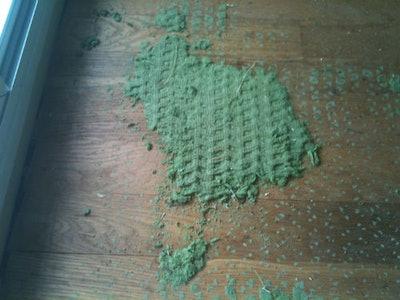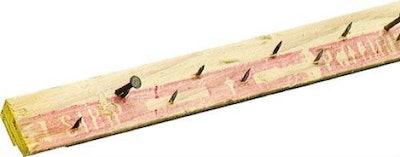Carpets have been around a very long time. The oldest known example of a carpet (the Pazyryk carpet) is over 2,000 years old and was discovered in a Siberian tomb. Of-course carpet manufacturing processes have moved on and now wall-to-wall carpets are commonplace.Does that mean that they are an ideal go-to floor covering? Particularly over tired wood floors?
You’d might think that we’re biased against carpets, given the fact that we are manufacturers of wood and stone composite flooring – and you’d be right. However, you must take into consideration that we have had ample opportunity to add carpets into our product range over the years. In our due diligence to ensure our products are not only environmentally friendly but also healthy, we came across a number of factors of carpets that we believe you should be aware of:
- They trap moisture. Whilst in some conditions this can relatively quickly be released, if it’s on a wood floor base, it’ll soak the timber below eventually leading to significant damage of both the carpet and the wood floor.
- Animals are more likely to soil carpeted areas. Given carpets proclivity for trapping liquids, this acidic and damaging ‘mess’ will require chemical cleaning to remove.
- Because of the moisture retention, it’s the ideal breeding ground for mold and mildew.
- Carpet beetles, moths, rodents (to name a few) will readily eat and nest in carpet.
- Dust, pollen and other airborne particulates are easily trapped in the fibres of carpet. It’s well known that Doctors will advise someone with allergies/respiratory issues to remove any carpets from the home.
- The underlay for carpets often breakdown, the residue of which will leach into a timber subfloor causing lasting damage.
- Carpet will have a lengthy ‘off-gassing’ period. You may have experienced this in a room with a new carpet, that smell is a combination of various VOCs and other airborne particulates which are hazardous to health.
As further evidence to the above, if you’ve ever seen carpet being removed, you’ll see the grime and dirt on the underside as well as possibly seeing the various colonies of insects and alike that have taken up residence. Add the fact that it will sit in landfill for many, many years without decomposing and you can quickly see it has a deleterious impact on both the environment and our health.
Fitting carpet over a wood floor
In addition to the realities what carpet does when in situ, some of the most telling and permanent damage from carpets comes with its installation.
The carpet gripper, which does ‘as it says on the tin’, is installed around the perimeter of the room. It is nailed into place and on the surface has a run of small sharp protrusions to hold the carpet in place. This is highly effective in gripping a carpet and the timber subfloor; however, they also easily pierce and tear skin if revealed and on removal are capable of lifting timber boards.
The carpet gripper, which does ‘as it says on the tin’, is installed around the perimeter of the room. It is nailed into place and on the surface has a run of small sharp protrusions to hold the carpet in place. This is highly effective in gripping a carpet and the timber subfloor; however, they also easily pierce and tear skin if revealed and on removal are capable of lifting timber boards.
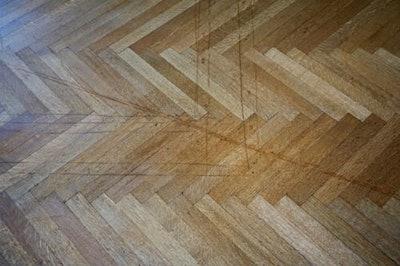
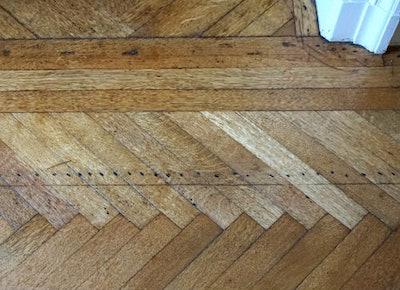
The image above shows cut marks on a beautiful, old herringbone floor (the likes of which could cost over £100m2 to have in your home). The damage is the result of a carpet fitter’s blade. Granted, this is an installer issue, not inherent with carpet itself, but it is a common problem. The correct method of installation would be to measure and cut the materials before bringing them into the room (or only cutting on a protected surface). What tends to happen is that the installer takes their knife, cuts through the carpet/underlay and into the floor as well. This leaves a deep gauge in the wood.
This provides any trapped moisture a direct route into the core of the wood floor which, at best, will water stain and at worst, cause severe warping and failure.
Restoring a wood floor is not always a straightforward task, particularly when dealing with deep cuts or nails that limit the extent to which the floor can be sanded. In such cases, filling may be necessary to minimize the need for extensive sanding. Additionally, if the floor is stained, completely eliminating the marks may prove challenging. The alternative of replacing boards, especially in older installations, can be a complex endeavour, leaving homeowners with the option of darkening the floor to conceal imperfections.
In a nutshell, covering a wood floor with wall-to-wall carpet is not an ideal solution. It poses risks to the floor’s integrity, is not environmentally friendly, and conceals a premium product that often just requires some tender loving care for rejuvenation.
For spaces with structurally sound but otherwise unusable wood floors, an excellent alternative is to use our Impervia rigid composite boards. These boards are waterproof, offer a realistic wood effect, and come with a non-toxic IXPE backing layer that preserves the underlying wood floor. Not only do they have a longer lifespan, but they also provide a significantly more hygienic option compared to carpets. Furthermore, they can be easily removed and reused elsewhere if you decide to restore the wood floor in the future.
Let us know if you’re working on a project with this type of conundrum. We’d be happy to help.
Related News Stories
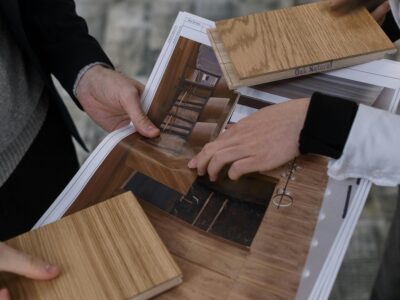
5 Reasons Why Solid Wood Flooring is the Preferred Choice for Architects and Designers
Read more
How to Choose the Perfect Solid Wood Flooring for Your Design Project
Read more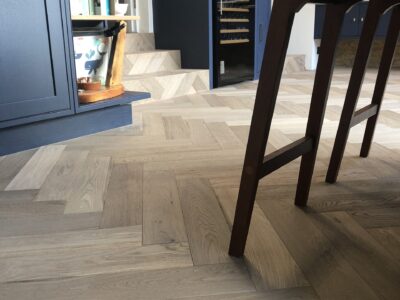
Engineered Wood vs. Solid Wood Flooring: Which is Right for You?
Read more
The Environmental Benefits of Choosing FSC-Certified Engineered Wood Flooring
Read moreJoin our mailing list
Receive the latest news, offers and inspiration straight to your inbox.

